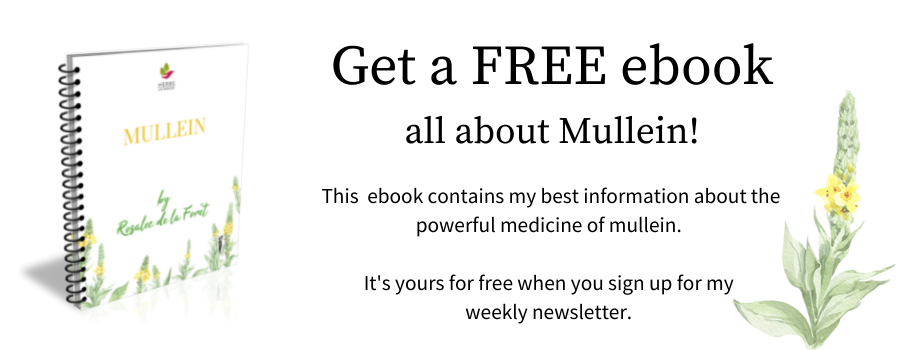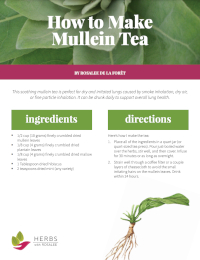Get weekly tips, recipes, and my Herbal Jumpstart e-course! Sign up for free today.
How to Use Mullein Leaf
Share this! |
|
In this video, I’m sharing how to use mullein, the respiratory health benefits of mullein leaf, and I’ll show you how to make mullein tea. Mullein is not only a beautiful sight with its towering flowering stalks and those creamy yellow flowers, but it’s also wonderful for coughs and lung inflammation from all kinds of irritants and pathologies, such as asthma or an upper respiratory infection. Once you experience mullein’s ability to soothe the respiratory system, you’ll be amazed at the power of this ubiquitous plant.
-- TIMESTAMPS --
- 00:00 - Introduction to mullein (Verbascum spp.)
- 03:12 - Mullein leaf for the lungs
- 05:04 - Nutritional benefits of mullein leaf
- 05:40 - Mullein for soil remediation
- 06:38 - Using mullein leaf topically
- 08:14 - How to identify mullein (Verbascum thapsus)
- 10:06 - Tips for harvesting mullein
- 11:36 - Special considerations for working with mullein
- 12:21 - How to make mullein tea
- 14:07 - Mullein Fun Fact
Download Your Recipe Card and Ebook!

l

Transcript of the How to Use Mullein Video
Mullein is one of my favorite friends of late summer. Not only is it a beautiful sight with its towering flowering stalks and those creamy yellow flowers, it’s also a welcome gift for supporting the lungs in these summers that are now often filled with wildfire smoke. In this video I’m sharing how to use mullein leaf, the respiratory health benefits of mullein leaf, and I’ll show you how to make mullein tea.
Hello! I’m Rosalee de la Forêt, herbalist, teacher, and bestselling herbal author. I created this YouTube channel to share trusted herbal knowledge so that you can get the best results when using herbs for your health.
Okay, let’s dive in...
I love watching my garden wake up in the early morning hours of the summer. As the sun readies itself to crest the eastern ridge, birds and bees and small mammals are beginning to stir. It’s easy for mullein to draw my attention. Those tall stalks often tower far above me, making them hard to ignore.
Mullein also draws attention because it is full of life. I often see hummingbirds resting on the stalks.
Woodpeckers often go up and down the stalk, perhaps eating the ants and other bugs as well as eating some of the millions of seeds that are forming.
One morning, while I was harvesting strawberries, I found a whole family of voles underneath the thick mullein leaves. The babies were small and hairless, probably only a few days old. The large leaves perfectly curled over their nook, offering a beautiful refuge from the world.
Whether you are considering mullein’s stature, its important role in the greater ecosystem, or its gifts of medicine, it’s hard not to be impressed with this beautiful plant.
Originally from Europe and Asia, mullein species have spread all over North America. They love disturbed soils with lots of sunlight. They can grow in rich garden soil as well as gravelly roadsides. The easiest time to find and identify mullein is in the later summer months and fall, when those tall flowering stalks become a beacon.
Some folks think of mullein as a weed, an uninvited guest from faraway lands. Perhaps because of its stature, mullein is an easy target for misplaced hatred or at least misunderstanding. It’s a strange thing that humans disturb soils and habitats and then blame the plants that come to nourish and heal the bare earth. Mullein, as generous as ever, offers many gifts and virtues to humans. My hope is that fewer people see mullein as an unwanted guest and more as a bountiful herb that we are lucky to have.
Mullein Leaf for the Lungs
Mullein leaf has long been loved for soothing the lungs and quelling coughs. It is a mild relaxant to the lungs and also a mild demulcent. It soothes inflammation and dryness – often the causes of irritation for people with smoke exposure.
I often combine mullein leaves with other demulcents such as mallow, marshmallow, or linden.
Mullein is wonderful for coughs and lung inflammation from all kinds of irritants and pathologies, whether it is particulate matter in the air or symptoms from asthma or an upper respiratory infection. Once you experience mullein’s ability to soothe the respiratory system, you’ll be amazed at the power of this ubiquitous plant. Yet it is a gentle herb that is safe for children and the elderly.
You can work with mullein as a tea.
And while it sounds a bit counterintuitive, inhaling mullein smoke is a way to directly get mullein’s relaxant qualities to the lungs, to relax constrictions and aid in stopping a cough. Like anything, this method can be overdone, but when you get it just right it can have dramatic and quick results.
So how does mullein work? Undoubtedly in many ways!
One study, published in July of 2021, showed that mullein contained many constituents that modulate inflammation.
In the conclusion of the paper the researchers stated that these “could serve as inspiration for the design of improved drugs to treat a wide range of pathologies, including respiratory pathologies, which are of particular interest at the moment, in the context of the COVID 19 pandemic.”
Mullein Leaf as a Nutritive
Mullein leaf is nutrient dense. When prepared as a nourishing herbal infusion, you can drink it frequently, not only to support lung health, but also to benefit from its high levels of calcium and magnesium4.
Mullein’s roots dig deep into the earth, bringing minerals and metals into its leaves. While this can result in nutritive leaves, mullein also has the ability to uptake heavy metals, which could pose a health hazard for humans but also positive benefits for the soil.
Mullein for Soil Remediation
Mullein is a hyperaccumulator of heavy metals. This means it can uptake heavy metals from the earth and store it. This ability has led to some interesting research on using mullein for soil remediation. Researchers in Serbia tested five different plants for cleaning up a heavily contaminated site.
Their research concluded: “Because mullein efficiently transported metal pollutants into the above-ground parts and because it fits well the desired characteristics for its use as a biomass, it is our plant of choice for further bioremediation use at the polluted industrial site.”1
Mullein is generally regarded as safe; however, it’s always important to harvest plants from healthy soils and to resist the temptation of roadside mullein plants.
How to Use Mullein Leaf Topically
Mullein boasts large hairy leaves which can feel like thick dense wool.
The complex web of plant fibers covering the leaves protect the plant from the strong rays of the sun. These same plant fibers are a bit irritating to human skin, which can be annoying, medicinal, or both.
Because of this potentially irritating action, when processing a lot of mullein leaves you may want to wear gloves.
The action of irritating the skin is called rubefacient. This irritation dilates the capillaries, increasing circulation to the area. This has a wide variety of therapeutic applications.
Used on the chest, mullein leaves can help move stagnancy in the lungs, increasing a healthy thin mucus that can be readily expelled.
And if you are simply interested in seeing a rubefacient work, try rubbing the fresh or dried leaves on your skin to see the results.
A clinical trial that was published in 2021 showed that people using a topical cream of mullein on episiotomy wounds had significantly better results than those using a placebo.
The study concluded that “Verbascum Thapsus is effective in repairing episiotomy wounds. The researchers hope that the results of this study can provide clinical evidence for the use of this herbal medicine in the wound healing process.”
How to Identify Mullein
Great mullein, Verbascum thapsus, is the most common species of mullein that is readily found in North America. There are other species that are used similarly such as V. virgatum, V. densiflorum, and V. olympicum. These two latter species have flower stalks that are denser than V. thapsus, making for an easier flower harvest. Medicinal seed suppliers often carry these other species.
Here I’ll describe Verbascum thapsus.
Mullein loves to grow in disturbed soils. It prefers sun and can grow in poor, gravelly soils.
Mullein is a biennial plant, meaning it takes two years for it to complete its life cycle.
In the first year, a large basal rosette of silvery green and hairy leaves appears. By the late summer and fall the leaves can be very erect and easily up to a foot in length.
In the second year, it sends up a long flower stalk. The bottom of the stalk will have leaves growing alternatively and becoming smaller with height. The stalk then transitions to yellow flowers. The height of this stalk can reach two meters or more.
The flowers have five petals and five stamens. They start blossoming at the base of the stalk and then bloom progressively up the stalk.
The flower stalk darkens to brown in the fall and often persists through the winter and even into the next year.
Mullein stalks produce millions of tiny seeds that will persist in the soil for hundreds of years.
The roots are thin, branched taproots with a creamy color.
Tips for Harvesting Mullein
The first step to making herbal preparations is harvesting the desired part at the right time. Because mullein is a biennial plant (taking two years to complete its life cycle), leaves can be harvested at the end of the first and beginning of the second year or any time they look vibrant and healthy.
Mullein often grows in colonies – where you find one mullein plant you find many! It readily spreads by seed and its many seeds stay viable in the soil for possibly hundreds of years. While mullein is not an endangered plant and it would be difficult to negatively affect a population, I still approach it with admiration and respect.
There have been times where friends have offered to let me weed their garden of mullein; in those cases I harvest the entire plant. However, when harvesting leaves and flowers in the wild, I harvest here and there to ensure a thriving population. If you live in an area where mullein is not abundant, then it will be especially important to harvest in a way that supports further plant growth and future plant harvests.
If you’d like more tips on growing, identifying and working with this marvelous plant then check out my book, Wild Remedies: How to Forage Healing Foods and Craft Your Own Herbal Medicine, which includes recipes for a mullein and yarrow facial steam and herbal burning bundles.
Special Considerations for Working with Mullein
The Botanical Safety Handbook gives mullein its highest safety rating, but there’s a couple of considerations worth mentioning:
- The dense wooly hairs on the mullein leaves can be a bit irritating. When garbling (or handling) lots of mullein leaves, you may want to wear gloves. When drinking an infusion of the leaves, strain it through a coffee filter or several layers of cheesecloth to remove any hairs from the tea.
- Mullein is a hyperaccumulator of heavy metals. Be certain that the mullein you are harvesting and using comes from healthy soils that aren’t contaminated with metals.
How to Make Mullein Tea
This soothing mullein tea is perfect for dry and irritated lungs caused by smoke inhalation, dry air, or fine particle inhalation. It can be drunk daily to support overall lung health.
- 1/2 cup (10 grams) finely crumbled dried mullein leaves
- 1/8 cup (4 grams) finely crumbled dried plantain leaves
- 1/8 cup (4 grams) finely crumbled dried mallow leaves
- 1 Tablespoon dried hibiscus
- 2 teaspoons dried mint
Here’s how I make mullein tea.
1. Place all of the ingredients in a quart jar (or quart-sized tea press). Pour just-boiled water over the herbs, stir well, and then cover. Infuse for 30 minutes or as long as overnight.
2. Strain well through a coffee filter or a couple layers of cheesecloth to avoid the small irritating hairs on the mullein leaves. Drink within 24 hours.
My success is seeing your success! So to make things easy for you I’ve created a free recipe card that you can download. It is located above this transcript.
If you enjoyed this video on how to use mullein and you value trusted herbal information, then I hope you’ll stick around! The best way to get started is to subscribe to my newsletter below so you can be the first to get my best herbal insights and recipes.

Citations for How to Use Mullein
Click to show/hide.
Rosalee is an herbalist and author of the bestselling book Alchemy of Herbs: Transform Everyday Ingredients Into Foods & Remedies That Healand co-author of the bestselling book Wild Remedies: How to Forage Healing Foods and Craft Your Own Herbal Medicine. She's a registered herbalist with the American Herbalist Guild and has taught thousands of students through her online courses. Read about how Rosalee went from having a terminal illness to being a bestselling author in her full story here.